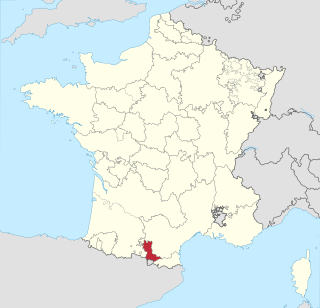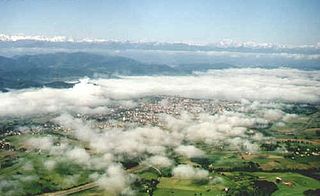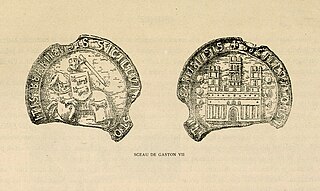
Midi-Pyrénées is a former administrative region of France. Since 1 January 2016, it has been part of the new region of Occitania. It was the largest region of Metropolitan France by area, larger than the Netherlands or Denmark.
The County of Armagnac, situated between the Adour and Garonne rivers in the lower foothills of the Pyrenées, was a historic county of the Duchy of Gascony, established in 601 in Aquitaine. In 960, the title of 'Count of Armagnac' was established, and thus the County of Armagnac was created. In 1751, following the death of childless Charles de Lorraine, Comte d'Armagnac, the county was absorbed into the Crown lands of France and the King, then Louis XV took the title of 'Count of Armagnac'. In 1791, following the decree dividing France into departments, the county was disestablished, but remains an important natural region of France.

The County of Foix was a medieval fief in southern France, and later a province of France, whose territory corresponded roughly the eastern part of the modern département of Ariège.

Bigorre is a region in southwest France, historically an independent county and later a French province, located in the upper watershed of the Adour, on the northern slopes of the Pyrenees, part of the larger region known as Gascony. Today Bigorre comprises the centre and west of the département of Hautes-Pyrénées, with two small exclaves in the neighbouring Pyrénées Atlantiques. Its inhabitants are called Bigourdans.
Quatre-Vallées was a small province of France located in the southwest of France. It was made up of four constituent parts: Aure valley, Barousse valley, Magnoac valley, and Neste or Nestès valley.

Nébouzan was a small province of France located in the foothills of the Pyrenees mountains, in the southwest of France. It was not a contiguous province, but it was made up of several detached territories, approximately half of them around the town of Saint-Gaudens in the south of the present-day département of Haute-Garonne, and the other half around the town of Lannemezan in the east of the present-day département of Hautes-Pyrénées. The capital of Nébouzan was Saint-Gaudens.

Gaston III, known as Gaston Phoebus or Fébus, was the eleventh Count of Foix and twenty-fourth Viscount of Béarn from 1343 until his death.

The viscounts of Béarn were the rulers of the viscounty of Béarn, located in the Pyrenees mountains and in the plain at their feet, in southwest France. Along with the three Basque provinces of Soule, Lower Navarre, and Labourd, as well as small parts of Gascony, it forms the current département of Pyrénées-Atlantiques (64).

The Duchy of Gascony or Duchy of Vasconia was a duchy located in present-day southwestern France and northeastern Spain, an area encompassing the modern region of Gascony. The Duchy of Gascony, then known as Wasconia, was originally a Frankish march formed to hold sway over the Basques. However, the duchy went through different periods, from its early years with its distinctively Basque element to the merger in personal union with the Duchy of Aquitaine to the later period as a dependency of the Plantagenet kings of England.
The County of Fézensac was an 8th-century creation on the north-eastern fringes of the Duchy of Gascony following Charlemagne's policy of feudalisation and Frankish colonisation. The move was aimed at offsetting and undermining the authority of the duke of Gascony Lupo II after the setback suffered by the Franks at the Battle of Roncevaux in 778 and failure to restrain the Basques. That advance clearly displeased the Basques, with these policies sparking a stir on the banks of the Garonne.

Roger-Bernard III was the Count of Foix from 1265 to his death. He was the son of Roger IV of Foix and Brunissende of Cardona. He entered into conflicts with both Philip III of France and Peter III of Aragon, who held him in captivity for a time. He was nevertheless a distinguished poet and troubadour.

Gaston VII de Montcada, called Froissard, was the twentieth Viscount of Béarn from 1229. He was the son and heir of Guillermo II de Montcada of the House of Montcada and of Garsenda, daughter of Alfonso II of Provence and Garsenda of Forcalquier. He was succeeded by Roger-Bernard III of Foix.
The House of Armagnac is a French noble house established in 961 by Bernard I, Count of Armagnac. It achieved its greatest importance in the fourteenth and fifteenth centuries.
Eschivat IV Chabanais was Count of Bigorre from 1255 to 1283 and Count of Armagnac and de Fézensac of 1255 in 1256. He was the son of Jordan, Lord of Chabanais, and Alix de Montfort, Countess of Bigorre.
Petronilla of Bigorre or Petronilla of Comminges was ruling Countess of Bigorre between 1194 and 1251. She was the only child of Bernard IV, Count of Comminges, and his wife Stephanie-Beatrice IV, Countess of Bigorre. Petronilla succeeded her mother in 1194 as Countess of Bigorre; she was also Viscountess of Marsan and Nébouzan through further successions. She reigned as countess for fifty-seven years, in which time she was married five times.
Alice of Bigorre (1217/1220–1255), also known as Alice or Alix de Monfort was suo jure ruling Countess of Bigorre between 1251 and 1255.
Martha of Marsan was a ruling Viscountess of Marsan. She was suo jure Viscountess of Marsan, which she inherited from her father.
Constance was suo jure Viscountess of Marsan as well as titular Countess of Bigorre, daughter of Gaston VII, Viscount of Béarn and his first wife Martha of Marsan. Constance inherited all of her titles from her mother and contended to inherit her father's Viscounty of Béarn. She was married three times during her lifetime, marrying into the royal families of Aragon, Castile and England.

Occitania is the southernmost administrative region of metropolitan France excluding Corsica, created on 1 January 2016 from the former regions of Languedoc-Roussillon and Midi-Pyrénées. The Council of State approved Occitania as the new name of the region on 28 September 2016, coming into effect on 30 September 2016.

Margaret of Béarn – also known as Margaret or Margueriteof Montcada was a noblewoman, who ruled lands near the Pyrenees mountains and in the southwestern part of present-day France. When her father died in 1290, she inherited the lands, assets and title, Viscountess of Béarn. In 1310 following the death of her sister, she inherited the assets and title of Countess of Bigorre.











